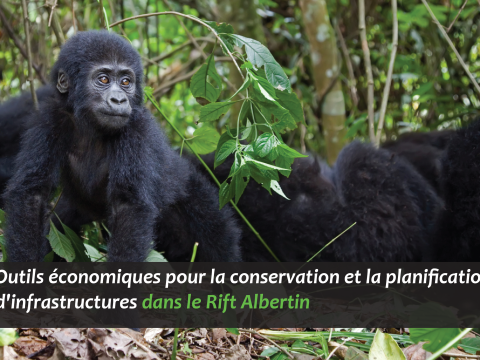Economic tools for responsible infrastructure
This past June I spent three weeks in Kinshasa, the capital of the Democratic Republic of Congo (DRC) facilitating one of CSF’s flagship Economics Tools for Conservation courses. The course focused on infrastructure planning and biodiversity conservation in the Albertine Rift. The course was delivered in partnership with L'École Régionale post-universitaire d'Aménagement et de gestion Intégrés des Forêts et territoires Tropicaux (ERAIFT). Holding the course in DRC was a great opportunity to share economic tools with conservationists and infrastructure planners that work in an area which faces new and rapid development options. During the comprehensive two-week program, participants were taught: introductory microeconomics, natural resource economics, environmental valuation and policy, and cost-benefit analysis (CBA). With this training, our DRC graduates can be more strategic and successful in their planning and development efforts related to infrastructure and the environment. This exposure is crucial at a time when the integration of ecosystem conservation into infrastructure planning and development is an essential component of long-term social and environmental wellbeing in the Albertine Rift, one of the most biodiverse regions on Earth. The discussions held during the course were an eye opener to the Albertine Rift’s biodiversity conservation and infrastructure planning challenges. Course participant Joël Wengamulay, Communications Director in the Virunga Landscape for the Economic Community of Central African States (ECCAS), concluded at the end of the course that: “the advantage of this training is that it helps you understand that conservation is not merely a question of feeling, it is not just a question of liking something or not. Conservation is also and above all, a question of the social value that we may or may not be able to put a figure on, but that means something for the community.” Joël also pointed out that the course would be useful to him in his region of work: “there are two main challenges: one has to do with valuing protected areas where we work, and the other with lack of infrastructure in the region… we need to know that the dollar that we invest, we invest it in the right place, that we invest it right, and most importantly that we do not cause more problems than the ones we currently see in the field.” Watch Joël speak about the challenges he faces and how the training has changed the way he thinks:Assumpta Uzamukunda, who works at the Rwanda Natural Resources Authority (RNRA), expressed that the course had changed the way in which she thought about conservation issues: “I had a tendency to think that conservation matters where only a matter of conservation… or else when I wanted to explain to people things related to conservation, I couldn't manage to tell exactly what it was about. But now with the tools that I have… it's much easier for me to communicate with people who don't work in conservation.” Watch Assumpta speak about infrastructure challenges in Rwanda and how the CSF course has given her tools to speak an entirely different language:The course was a success thanks to the diverse experience and knowledge of course participants and instructors. Michel Baudoin, ERAIFT’s Director, did an outstanding job, teaching microeconomic in a very practical and dynamic way. Vanja Westerberg, from IUCN’s Global Economics Program, taught natural resource economics, environmental valuation methods, and environmental policies. She brought to the table up-to date information that encouraged ongoing discussion. Vanja also conducted environmental economics exercises that helped students understand how some environmental economic tools work and how they can be used. Veronique Fournier, of Cambridge Resources International, taught students the ABC of conducting CBA. She explained how these analyses can be interpreted and appropriately implemented to account for the environment within infrastructure development. Students were fascinated by Veronique’s step-by-step approach to building cost-benefit analysis. For my part, I supported trainers and encouraged discussions related to course topics. I also ran experiments and exercises, such as a potato market exercise and the prisoner’s dilemma experiment. During the potato market exercise, course participants get the chance to act as agents of the market and experience how market forces work. The prisoner’s dilemma experiment allowed students to experience how collaboration, which results from non-binding communication, can sometimes be remarkably more effective than moderately enforced government regulation when managing local environmental resources. See the Potato game in action:The final day included group presentations of our signature graduation exercise: the Asante Dam Case Study (called Esperanza Dam in other CSF courses). During this exercise, course participants were given basic information to carry out a simplified cost-benefit analysis of a hydroelectric project. They were grouped into teams that presented their analysis. Through the presentations, it became evident that course participants had embraced key environmental economic concepts introduced throughout the two-week course and had developed a strong ability to understand the essential components of cost-benefit analysis and environmental economics more broadly. This training was made possible by the support of the American People through the United States Agency for International Development and its program on Biodiversity Understanding in Infrastructure and Landscape Development (BUILD), implemented by Conservation Strategy Fund. The Handsel Foundation also provided support for this training. Further collaborations were key to the success of this course, these included: Wildlife Conservation Society DRC; Cambridge Resources International; IUCN’s Global Economics Program. Notably, the course would not have been possible without the help of the following key on-the-ground individuals: CSF course graduates Ephrem Balole of Virunga’s National Park Planning Officer; Godeliève Konunga, Research Assistant at ERAIFT; and Papy Shamavu, WCS’s Virunga Conservation Project Manager.
- Log in to post comments


